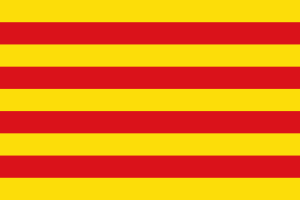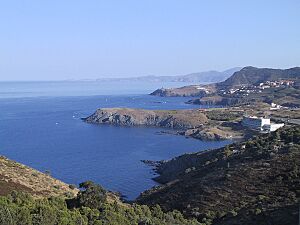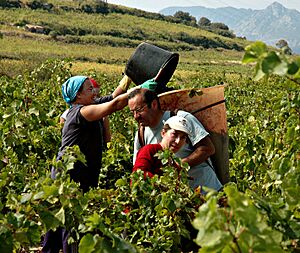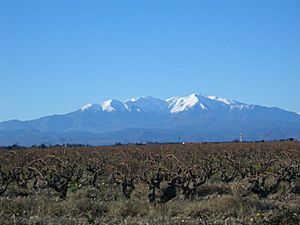Roussillon facts for kids
Quick facts for kids
Roussillon
Rosselló (Catalan)
|
|||
|---|---|---|---|
|
Historical province
|
|||
|
|||
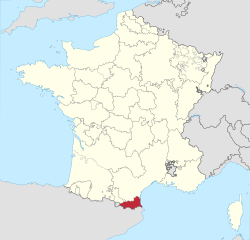 |
|||
| Country | France | ||
| Department | Pyrénées-Orientales | ||
| Largest settlement | Perpignan | ||
| Area | |||
| • Total | 3,600 km2 (1,400 sq mi) | ||
| Population | |||
| • Total | 450,000 | ||
| Time zone | UTC+1 (CET) | ||
| • Summer (DST) | UTC+2 (CEST) | ||
Roussillon (pronounced "Roo-see-yon" in French, or "Rosselló" in Catalan) is a historic area in France. It used to be a province of France. This region was once part of the Principality of Catalonia. Today, it is mostly the French département (like a county) called Pyrénées-Orientales. This area is also known as Northern Catalonia by people who speak Catalan. It is located in the southern part of France, near the border with Spain.
Roussillon's Early History
The name Roussillon comes from an old fortified place called Ruscino. This place was near the modern city of Perpignan. In ancient times, leaders from the area met there.
From 121 BC to AD 462, Roussillon was part of the Roman province of Gallia Narbonensis. Then, it became part of the Visigoth kingdom. In 719, a group called the Saracens (Muslims from North Africa and the Middle East) crossed the Pyrenees mountains. They took control of the area.
In 759, Pepin the Short, a Frankish king, defeated the Saracens. He took over Roussillon. The Carolingians (another Frankish royal family) then ruled the area. In 778, Charlemagne (a famous Carolingian emperor) found the region damaged by war. He gave land to Visigoth refugees and started monasteries.
In 792, the Saracens attacked France again. But they were stopped by Count Guillaume of Toulouse. His power reached into Catalonia.
Counts and Kingdoms
Over time, different parts of the kingdom became independent areas called fiefs. In 893, Sunyer II became the first count of Roussillon. But his rule only covered the eastern part of the future province. The western part, called Cerdanya, had its own count, Miró, starting in 900.
The counts of Roussillon often fought with other powerful nobles nearby. Count Girard I joined the First Crusade in 1099. He was one of the first to enter Jerusalem when it was captured.
By the 12th century, the Counts of Barcelona became very powerful. The Counts of Roussillon had to promise loyalty to them. In 1111, Ramon Berenguer III, the Count of Barcelona, gained control of Besalú. Then he added Cerdanya in 1117.
The last count of Roussillon, Girard II, had problems with his half-brothers. To prevent them from inheriting his lands, he left everything to Alfonso II of Aragon. Alfonso took control in 1172. Under the Aragonese kings, the region grew richer and had more people. Collioure (Cotlliure), the port of Perpignan, became a very important place for trade in the Mediterranean Sea.
Border Conflicts and French Rule
As the French and Aragonese kingdoms grew stronger, Roussillon became a border area. This meant it was often a place of war. In 1258, the Treaty of Corbeil (1258) was signed. Louis IX of France officially gave up his claims to Roussillon. He recognized that it belonged to the Crown of Aragon.
James I of Aragon conquered the Balearic Isles from the Moors. He combined these islands with Roussillon to create the Kingdom of Majorca. Its capital was Perpignan. In 1276, James I gave this kingdom to his son, James II.
Later, James II had disagreements with his brother, Peter III. Philip III of France used this to his advantage. Philip III supported James II and led an army into Catalonia. But he died in Perpignan in 1285. James II then made peace with his brother.
In 1311, James II was followed by his son, Sancho I. Sancho I started building the cathedral of Perpignan before he died in 1324. His successor, James III of Majorca, refused to show loyalty to Philip VI of France. He asked Peter IV of Aragon for help. Peter not only refused but also declared war. He took Majorca and Roussillon in 1344.
Roussillon was now reunited with the Principality of Catalonia within the Crown of Aragon. It had peace until 1462. In that year, John II of Aragon had problems with his son. Louis XI of France supported John against his rebelling subjects. French troops occupied Roussillon until 1493. Then, Charles VIII left the region as part of a deal with Ferdinand the Catholic.
France and Spain fought over Roussillon between 1496 and 1498. The Spanish, led by Ferdinand, secured Roussillon. They even pushed into southern France. Eventually, the new French king, Louis XII, signed the Treaty of Granada (1500).
In 1516, the Habsburg family took control of both the Crown of Castile and the Crown of Aragon. This meant that Charles V, Holy Roman Emperor (also known as Charles I of Spain) ruled both.
In 1542, Perpignan was attacked by French forces. But the people of Perpignan stayed loyal to Charles V. Because of this, Perpignan was called "Fedelissima" (meaning "Most Faithful City").
In 1640, the Catalans rebelled against the Spanish king. Louis XIII of France joined the fight on the Catalans' side. After a long war, the Treaty of the Pyrenees was signed in 1659. This treaty divided the Principality of Catalonia. Roussillon and part of Cerdanya became part of the French kingdom. This created the French province of Roussillon.
For the next 50 years, Louis XIV tried to make his new subjects loyal to France. He also tried to change their culture to be more French. He succeeded in making them loyal. But outside of Perpignan, Roussillon stayed very Catalan in its culture and way of life. This lasted until the late 1800s, when new industries started to make people feel more French.
During the French Revolution, the old province of Roussillon was removed. A new department, the Department of Pyrénées-Orientales, was created. This new department is similar to the old Roussillon, but it also includes the area of Fenouillèdes. Pyrénées-Orientales is still the official name of this department in France today. The old name Roussillon was used in the name of the French région of Languedoc-Roussillon.
See also
 In Spanish: Rosellón para niños
In Spanish: Rosellón para niños
- Northern Catalonia
- Roussillon wine




